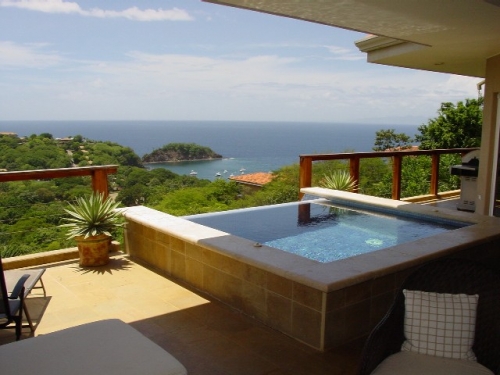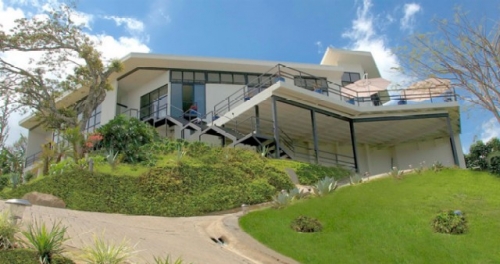Costa Rica Guide
Costa Rica Real Estate
List your property today!
Inclusion of real estate listings at Costa Rica Guide is
absolutely free of charge.
Featured Properties
Costa Rica Guide - Costa Rica Real Estate
With more native and migratory species than all of North America, Costa Rica is a bird-watching paradise
Susana Barciela
Miami Herald
SAN GERARDO DE DOTA, Costa Rica -- Nov. 5, 2006 -- The first time we caught a glimpse of him, all we saw were a few green tail streamers. There he was, the resplendent quetzal, reputed to be the world's most beautiful bird and now threatened by habitat loss. He was hiding in his nest, a hole in a dead tree trunk in a cloud forest -- and this was only day one of our Costa Rica birding tour. Next day at 5:30 a.m. we regrouped to stake out the nest. Sure enough, Mr. Quetzal soon was spotted flying into the forest clearing. His head looked like a green cotton ball. Aqua feathers on his back and sides framed a crimson chest. White feathers lined the inside of his tail leading to blue-green streamers trailing more than two feet. As he turned, the early-morning light hit his feathers, and he glittered, simply resplendent. No wonder the Mayan and Aztec civilizations of Central America revered this bird as divine. But the quetzals weren't the only beautiful or rare birds on the tour. We saw so many stunning birds -- 355 species altogether, 31 hummingbirds among them -- that it's difficult to name just a few.
With some 880 different native and migrant birds, Costa Rica, a country smaller than West Virginia, has more bird species than all of North America. Its species and habitat diversity make it a world-class eco-tourism destination and a birder's paradise. Our 10-day tour in April was sponsored by Miami-Dade's Tropical Audubon Society and conducted by Exotic Birding. My husband, Dan and I and six others paid $2,650 each, plus airfare. Brian Rapoza, Tropical's field-trip coordinator, came along to evaluate the experience. Our guide, Marcos Soto, one of Costa Rica's best naturalists, spotted and identified hundreds of birds by sight and song and drew birds to us by imitating their calls. Starting in San Jose, we drove south to private preserves in the Talamanca Mountains and southwest to the San Isidro Valley on the country's Pacific slope. We rode northeast to visit nationally protected forests near Chilamate de Sarapiqui and then southwest to Tarcoles near the Pacific coast. In the process we experienced habitats ranging from high-elevation cloud forests to coastal mangroves, spotting birds on wires, in fields and overhead on the roads along the way. The "ah" moments weren't limited to birds, either. The wide diversity of wildlife we saw included howler monkeys, three-fingered sloths, tiny poisonous frogs and peccaries that look like prehistoric pigs. People had different reasons for coming. Annemarie Brockmann, a retiree from Palmetto Bay who came with husband Lester, had wanted to see a quetzal for decades. Veteran birders Lillian and Doug Wassmer from the Tampa area added more than 160 new birds to their "life list." Dan and I enjoy the amazing natural habitats that birding takes us to and meeting other nature lovers as much as we like seeing birds.
FLYING JEWELS
Savegre Mountain Hotel, just a few hair-pin turns off the Pan-American Highway, sits at about 7,200 feet elevation in the Talamanca Mountains and is surrounded by lush, cloud forest. Feeders outside the hotel's dinning room provided great views of hummingbirds. We risked being side-swiped by iridescent blurs by standing too close, however. The hummers love to fight each other for just the right feeding spot. Who knew such tiny, jewel-like birds could be so aggressive?
After two nights at Savegre, we headed toward the San Isidro Valley and Los Cusingos, the farm of the late Alexander F. Skutch, a celebrated tropical-bird biologist. Now a bird sanctuary, the farm is owned by the Tropical Science Center, a foundation that also runs the Monteverde Cloudforest Preserve, a better-known eco-tourism site northwest of San Jose. In our afternoon there we caught our first views of the fiery-billed aracari, the farm's namesake, a toucan-like bird, only smaller. We also saw our first toucans, chestnut-mandibles, distinguished by their enormous bills and bright-blue legs. Another first: The blue-crowned motmot, spotted just as we hiked into a wooded area. Motmots trail a long tail with two feathers that hang off thin strings, as if two tiny racquets hang off the bird. Camouflaged in a thicket, this motmot was swinging its tail like the pendulum of a grandfather clock. We found great roadside sites near the Selva Verde Lodge, on the Caribbean slope of north Costa Rica. A small wetlands area contained familiar shore birds such as the great egrets and great blue herons. We also found rarities such as the endangered green ibis, which looks similar to our own glossy ibis. Then there was the pleasure of finding a bird that stumped Marcos -- at first. Hidden in the reeds, the bird snaked his long neck and head up, scouted around and popped down, only to reappear in another spot minutes later. None of us could could positively identify the big bird. When Marcos ran over, he was puzzled, too. He had to resort to a field guide to ID the bird. Though he has seen more than 700 species of Costa Rican birds, this was his first pinnated bittern -- a very secretive species. At the Selva Verde Lodge, we were walking around the patios when, alerted by Marcos, we looked up to see a pair of great green macaws. These endangered parrots stretch a yard in length.
THE RAIN FOREST
Two nearby locations invited more-intense birding: Braulio Carrillo National Park and La Selva Biological Station. Leaving at 4:30 a.m. from the lodge, we arrived at the park's Quebrada Ranger Station before 7 a.m. -- just as a downpour began. Two hours later, although it was still raining, Marcos took us in for a hike. This is a rain forest, after all, and all of us were decked out in rain gear. The foliage was soaked and dense. Nonetheless, we were rewarded with a view of a lattice-tailed trogan and his white-and-gray, horizontal-striped tail; as well as several reclusive antbirds. Hours later we had to fend off battalions of army ants as we neared the end of the trail. The next day at the biological station, a research facility, the rain held off until late afternoon. One highlight: a white-collared manakin performing its mating dance. This little white-and-black bird made a huge racket as it jumped several feet, back and forth repeatedly, accompanied by loud pops. Brian dubbed him the "popcorn" manakin, which is exactly what he sounded like. Inside the station, we hiked into the lowland forest where we spotted big birds swooping into tall trees. They turned out to be a pair of pale-billed woodpeckers, tropical cousins of the American ivory-billed species that was thought to be extinct but may have been recently sighted in Arkansas. The pale-billed has a red crest and black back with diamond-shaped markings. Its hammering is audible for quite a distance. Our last destination, Carara National Park, took us near the central Pacific Coast to one of two areas in the country where scarlet macaws are common. On the way, we stopped at the impressive La Paz Waterfalls, in Vara Blanca just an hour's drive north of San Jose. Nearby is recently active Poas Volcano.
LAPAS LUXURY
Close to the Pacific, we stopped at a bridge overlooking the
Tarcoles River to see crocodiles lounging on the river banks. Our
last three nights we stayed in luxury -- read air conditioning --
at the Villa Lapas Hotel, lapas meaning macaws. We saw the first
TV set in days, a big screen in a gazebo next to an inviting pool.
Not that we had any time for a TV or a dip with what awaited us
in Carara's forests, a transition zone that attracts birds of both
rainy and dry climates. We arrived at the entrance to the park's
Laguna Meandrica Trail before dawn to walk into the pitch-dark and
silent forest. The only discernable movements were of bats brushing
past. The first streaks of light revealed the outlines of trees
as we heard the first bird calls, owls mostly. Like an opera slowly
opening, the forest came to life. Before long, we were steaming
in the heat, listening to a wildlife symphony and searching for
new birds. We heard the loud squawks of scarlet macaws and saw dozens
of the huge parrots overhead. On our last afternoon, we headed out
for a cruise at the mouth of the Tarcoles River and surrounding
mangroves. We saw magnificent frigatebirds and little blue herons.
We could have been on Florida Bay, if not for the mangrove black
hawk and the mountains in the background. As the sun set over the
Pacific Ocean, a roseate spoonbill beckoned us home.
Copyright
(c) 2006, The Miami Herald
Note: The above information is not to be used for any other purpose other than private study, research, criticism or review. Thank you.






